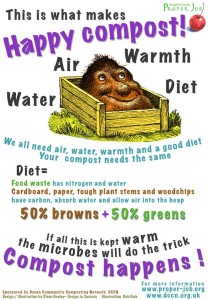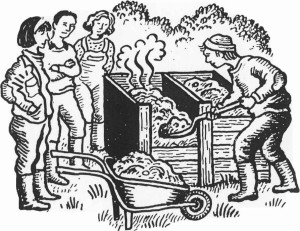The simplest and purest recycling that most of us can do is composting. If you learn some simple basic requirements then it will turn into a satisfying habit and will build the health of your soil and plant health. The other great bonus is you will save money on not having to buy in compost.
How to…
 The same basic principles apply to composting whether you have a tiny garden with a just enough room for a ‘Dalek’ composter or you are composting thousands of tonnes at a centralised composting facility. The composting process is done by the creatures that live in the compost heap, and our job as human composters is to create the ideal conditions for them to do their work. The conditions are known as ‘The Mantra’.
The same basic principles apply to composting whether you have a tiny garden with a just enough room for a ‘Dalek’ composter or you are composting thousands of tonnes at a centralised composting facility. The composting process is done by the creatures that live in the compost heap, and our job as human composters is to create the ideal conditions for them to do their work. The conditions are known as ‘The Mantra’.
Think about what all life on the planet needs: the most basic needs of just about all life. You know them: Food, Water, Air and Warmth. (the illustration here uses a drawing by Bob Gale on a board designed by Steve Dooley one of a set of three designs)
Of course everything we are putting on the compost heap is Food for something. All these materials are generally either wet and soft or dry and hard. The wet or ‘green‘ materials will provide water and the dry ‘brown‘ materials will create airways throughout the compost heap. The warmth is generated by the composting process, through the explosion of microbial life, and is maintained through either the insulation provided by the bin’s construction or through the mass of material in the pile.
So successful composting really boils down to being thoughtful about the materials you have and how you layer or mix them up, paying great care to mix soft wet materials with plenty of tougher stuff to allow airflow. There are different approaches needed to composting successfully depending on the materials you have and the context you are composting in and the pages here should cover most eventualities, whether you have garden waste or food waste, are looking at composting at home, at school or as a community.





